Rocket League Ping Spikes and packet loss
-
@RGK1 tried IPFire, Opnsense and fq-cake in openwrt but return to PFsense everytime as i get the best performance with fq-codel in it, when testing with flent. Probably could tweak it somewhere in some of the other distributions but tweaking just isn't as user friendly in them in my opinion.
Might just have gotten used to PFsense over the years :)
For testing your modem if it is affected by the PUMA bug you can use pingplotter and set it to ping e.g. google.com in intervals of 0.05-0.02 seconds, always nice with a graph to look at and it should be quite obvious if you are affected. -
How much deviation in the ping are we talking about, because after the initial spike, the ping seems okay, however personally i have to say i dont have much experience with ping plotter so couldnt say.
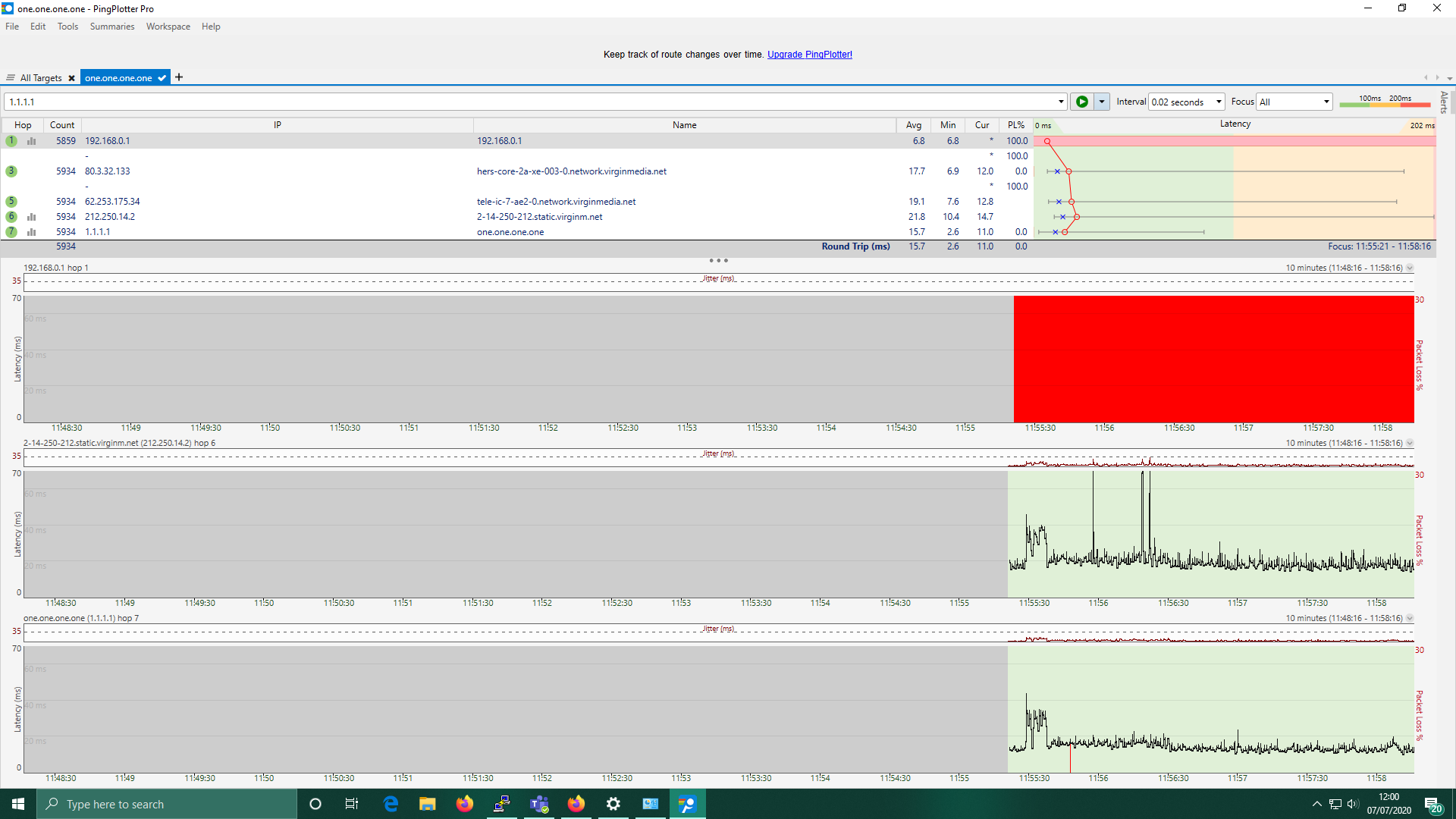
Ryan
Edit: Okay scrap that after a rerun for some reason it got completely worse.
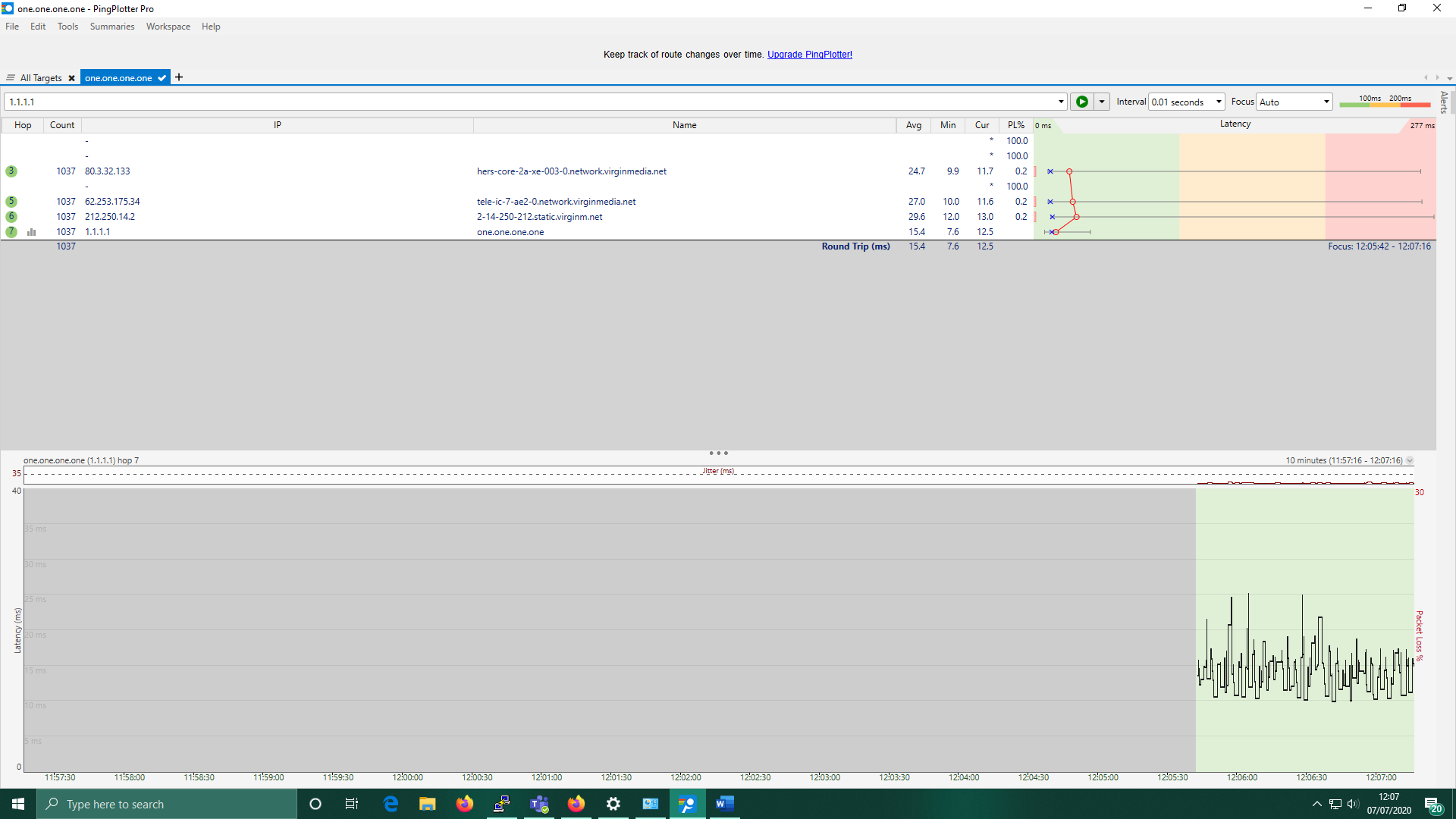
But apparently putting the router into modem mode helps this issue as i mentioned before allowing pfsense to have the external ip address and handle all the routing etc - making the virgin hub a bridge between the ethernet and docsis. However, when i try to set this up with both pfsense and opnsense i can ping from both lan and wan interfaces - however i cannot ping or connect to the internet with any clients on the lan interface with rules on the firewall allowing traffic both in and out from any source. I'd really like to try this and get this to work to shift the work to the pfsense box but it just wont budge. Also when changing back to router mode (re-enabling wifi and dhcp etc) the pfsense and opnsense both work fine once they gain the correct ip, and no other changes made.
Ryan
-
@RGK1 tman222 posted https://www.theregister.com/2016/12/03/intel_puma_chipset_firmware_fix/ where there is a comparison in ping plotter of a working modem and an Intel PUMA modem you can compare your own results to.
I would keep the comparison to the endpoint as intermittent hops isn't prioritizing ICMP traffic, and there can be large deviations in response time, and is only really useful if the endpoint has the same deviations which your plot doesn't.
So if i understood you correctly you can ping hosts on the internet and on LAN from Pfsense but you can not connect to the internet from anything connected to LAN when your modem is in bridge mode?
If that is the case have you made any changes to Pfsense? -
Pretty much correct, ive tried but when the router is in modem mode the pfsense box becomes the router gaining the correct external ip address on the wan ip (directing traffic and assigns the routes to external and internal ips) even after resetting to defaults it can get the external ip and can ping external networks (1.1.1.1) but my client a pc directly attatched can ping the local gateway (lan ip) 192.168.1.1 and the wan ip address (beggining with 86) however it cannot ping the external gateway nor any other networks. And when resetting to defaults and having the router in router mode the system works fine first time. Also when directly attatching only my pc to the rouuter in modem mode i can gain the correct external ip address and browse the internet just fine - i also did a dslreports test too - http://www.dslreports.com/speedtest/64771697
I guess from the comparison to the ping plotter graph from the article linked the patch that they applied may have actually done something?
Hope this helps
-
Hi @RGK1 - after doing a little bit more research, it looks like Virgin did address the Puma 6 issue, although some people are still reporting problems:
https://www.reddit.com/r/VirginMedia/comments/emz4w2/did_virgin_media_ever_fix_the_faulty_puma_latency/
Do you mind sharing with us the specs of your pfSense box as well, including brand and type of network interfaces you are using?
Thanks again.
-
Hi @tman222
I was looking at that post this morning in fact - I have a amd a8 7600 4 core cpu 3.1ghz 16gb of ram with 1 intel gb nic and 1 realtek gigabit nic with all hardware offloading disabled
-
Have you done any manual IP settings, on the host that can't connect to the internet, when using Pfsense with your Super Hub in bridge mode?
Also, when your trying to ping outside your LAN from the host are you pinging an FQDN address or an IP address? -
Yes - is manually set the ip and turned of dhcp on the server so the other clients are affected. The lan ip on the server is 192.168.1.1 and the client directly attached to the lan port was 192.168.1.2 subnet 24 and gateway 192.168.1.1 and dns 1.1.1.1. For either the pc and pfsense as the 'host' i used 1.1.1.1 to ping to and to make sure dns look ups were working on the pfsense box i pinged google.co.uk - only on pfsense box because again no connectivity on pc.
Many Thanks Again :)
Ryan
-
Hi @RGK1 - One thing to doublecheck is to make sure you are using the right default gateway under System > Routing > Gateways. Hope this helps.
-
I did check this and its basically as it should be (external ip but drop last 2 digits for a 1) :).
Thanks
-
@RGK1 - how did you setup fq-codel? Did you use floating rules on your WAN interface or limiters on an outbound traffic rule on your LAN interface(s)? Do you mind showing a screenshot of the relevant firewall rules to us? Perhaps we can see if something misconfigured from there. Thanks again.
-
Just as a note, but when i reset to defaults it works for having the router in router mode straight out of the box after automatic assigning of interfaces however if i again reset to defaults and put the router to modem mode i can get the external ip but cant get a connection.
I will try and get a screeshot o the firewalls but i think this may be irrelevant as everything should be stock (in theory).
-
Hi so i was able to get it working - after a couple days break and restart it seemed to work, but my problem is im getting quite varied results this is with modem mode enabled. With the same settings i get varying results. Im currently getting and A-B from C originally however even with fq codel im experiencing ping spikes in rocket league again with over 900ms and packet loss. These are my settings.
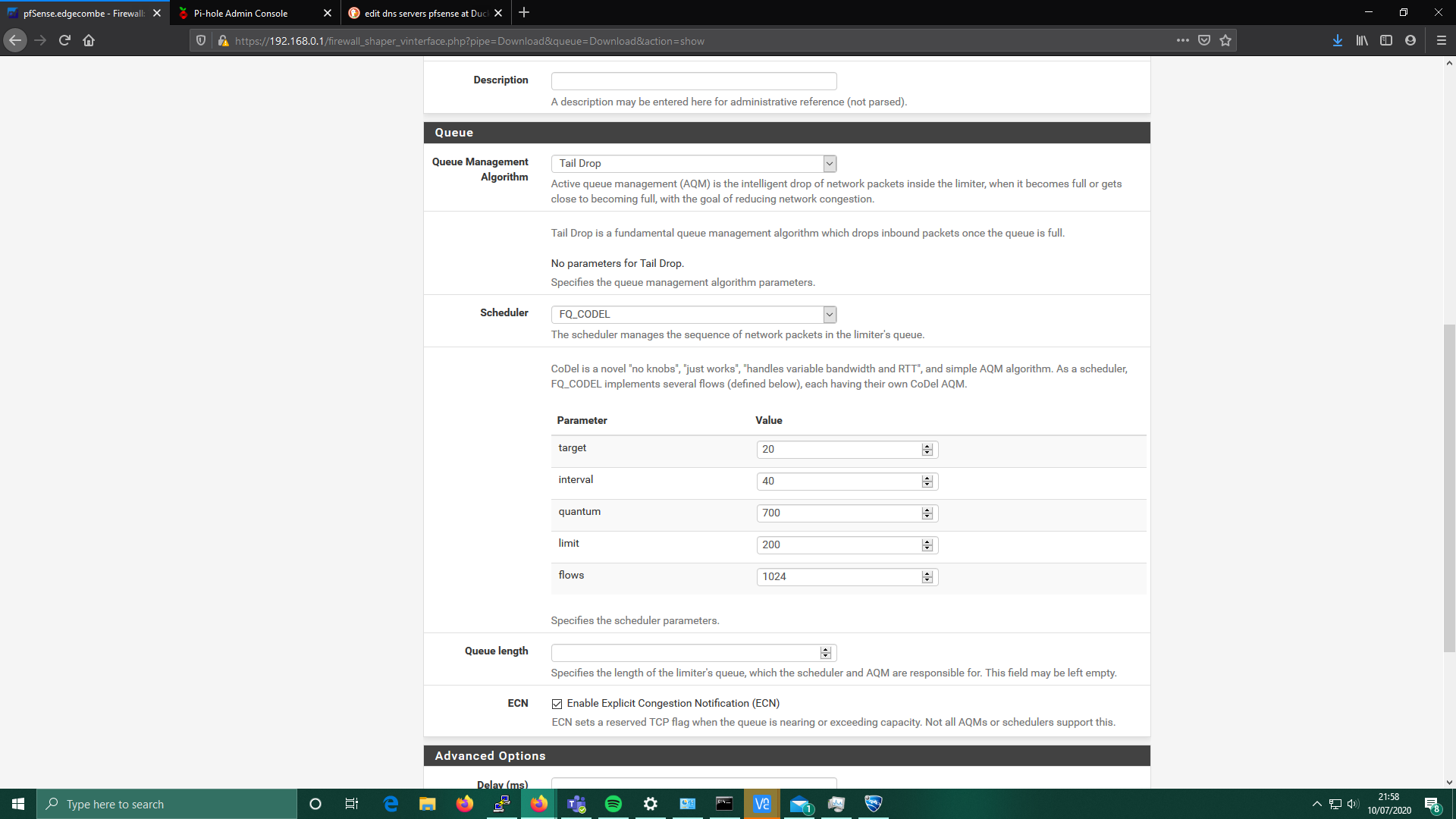
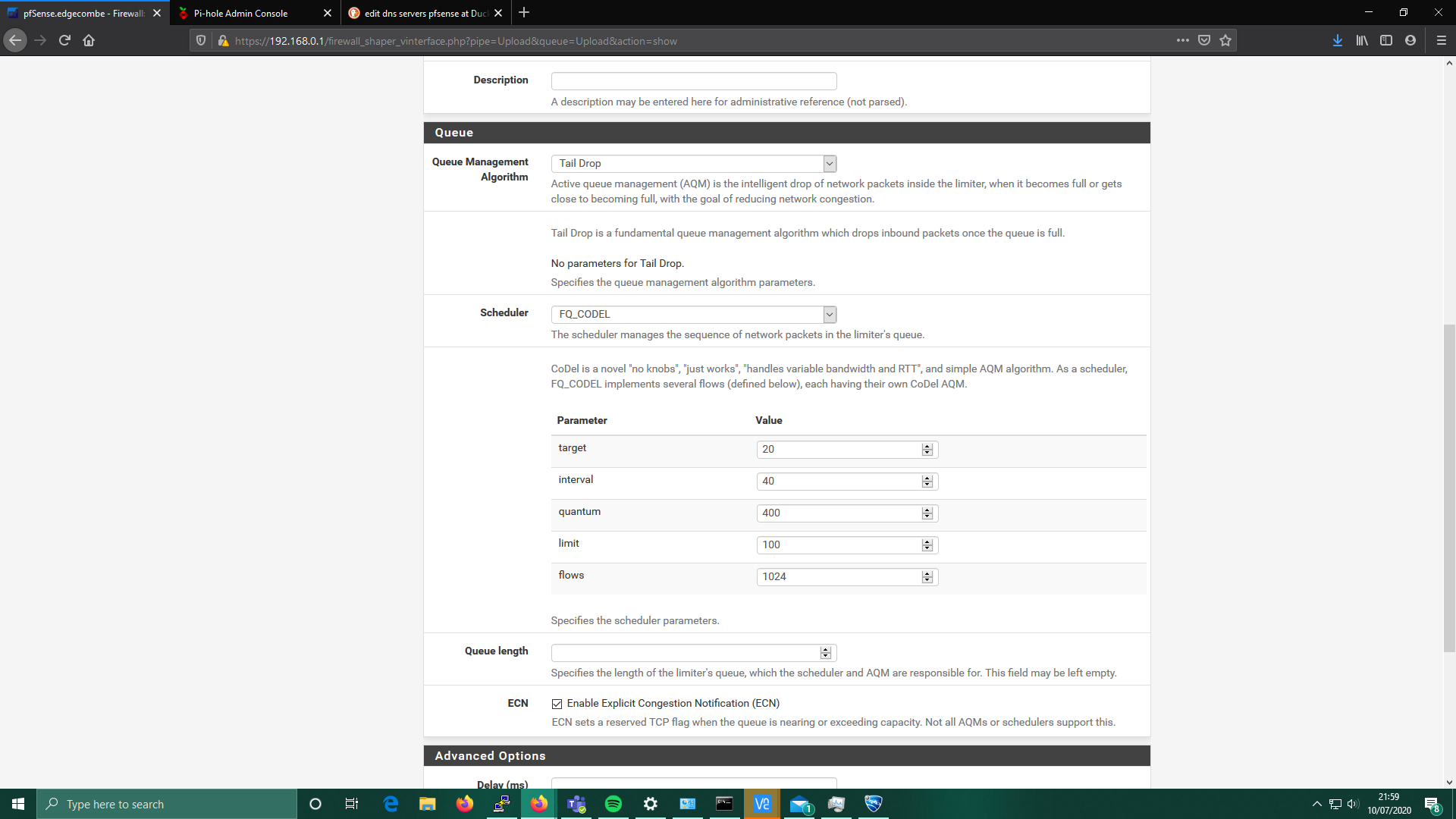
Top is download at 140mbits on a 200mbit connection but mainly stays around 220 and upload 12mbit on 20mbit normally 22 mbitIs there anything that i should change or am missing here causing these sudden ping spikes?
Edit: according to the in-game stats im mainly loosing packets on the outbound roughly 3-9 but sometime this goes upto 71 the servers are 60hz tickrate.
Edit2:may have found my problem set the limit too low and quantum too high possibly explaining the packet loss as it won't be prioritising the smaller packets :D
I'll test this tommorow.Ryan
-
@RGK1 are you or others generating any traffic on your connection that would cause the ping spikes?
If you know the IP of the server in rocket league you could try and ping it with pingplotter and you should be able to see if the latency spikes happens on your connection or further onto the internet.
Furthermore, recommended setting for target is 5-10% of interval. -
This post is deleted! -
@JammEr21 What kind of connection do you have?
-
For those wondering, there is a bug with the SH3 and FW 9.1.1811.401 when specifically the router is modem only mode and the firewall is PfSense, it doesn't seem to affect other hardware routers, but PfSense and OPNsense.
I've put a limiter on my download and uploads speeds and get A, A, A on dlsreports, bufferbloat stays low, but give or take every hour or so i do get spikes, which i am filtering slowly with trafic shaping.
Not a fix, but does mask the issue VMs router is giving.
In case it helps, here is my last days chart
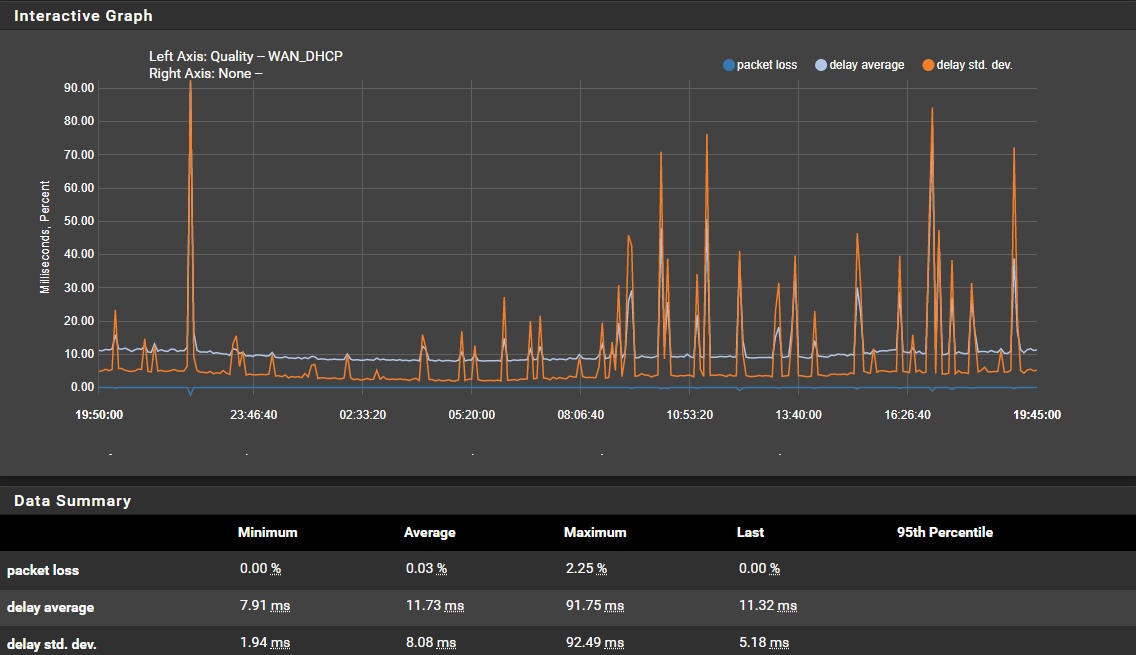
-
Sorry guys about my recent inactivity, i'm a 16 year old student that just gone back into education. I haven't really recently had time to investigate further as i ended up hitting a brick wall. Either it was slow speeds A buffer-bloat or viceversa. was able to get better results using OPNsense achieving i believe between an A (i think - sometimes may have dipped to B) and this was the best i was able to consistently achieve with pf-sense going from a C (through pf-sense with router in modem mode and no limiters) which i believe which is an improvement. I believe i used 13mbps up and 150mbps down on a 200mbps down connection. Sometime when i set the limiter to a higher speed i get worse bufferbloat scores than stock say 180 mbps and im getting only a C. However, recently i've stuck with stock settings without pf-sense or opnsense works better as i just ran a test achieving (220.6mbps down and 21.6mbps up as virgin over-prevision speeds) and got A+ connection quality and B rating buffer-bloat and honestly i haven't thought it to be worth the loss in speed - unless there's anything else i can try...
Here's the result if anybody wants to see as it shows the buffer-bloat in more detail - idle vs downloading and uploading - http://www.dslreports.com/speedtest/65616525
This was my last result where i got A buffer-bloat rating using OPNsense - http://www.dslreports.com/speedtest/64830336
Hopefully this helps in diagnosing - and i'm down for tinkering ;)
-
Use limiters as per this guide
https://www.youtube.com/watch?v=iXqExAALzR8
Be sure you flush your states before you try otherwise you may have inaccurate results
Do note with 200Mbps you may want to change your root limiter queue length to ~2000, I have 350-380Mbps down and 3000 works best for me.
Same on the upload queue, but play with those settings, less than 3000 for me still gave me high buffer bloat, the default settings may not be enough, so try somewhere between 1500 and 2500 for your speed
-
If you are not using limiters, then note this from the guide;
The ALTQ framework is handled through pf and is closely tied to network card drivers. ALTQ can handle several types of schedulers and queue layouts. The traffic shaper wizard configures ALTQ and gives firewall administrators the ability to quickly configure QoS for common scenarios, and it allows custom rules for more complex tasks. ALTQ is inefficient, however, so the maximum potential throughput of a firewall is lowered significantly when it is active.
pfSense software also supports a separate shaper concept called Limiters. Limiters enforce hard bandwidth limits for a group or on a per-IP address or network basis. Inside of those bandwidth limits, limiters can also manage traffic priorities.